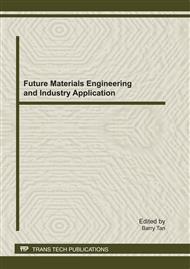[1]
D. H. Murray, J. Mendez, and S. A. Brown, The Nature of Coumarins: Occurance, Chemistry and Biochemistry; Wiley: New York, (1982).
Google Scholar
[2]
R. O'Kennedy and R. D. Thornes, Coumarins: Biology, Applications and Mode of Action; Wiley & Sons: Chichester, pp.209-239, (1997).
Google Scholar
[3]
A. K. Mitra, A. De, N. Karchaudhuri, S. K. Misra, and A. K. Mukopadhyay, Synthesis of coumarins in search of better nonpeptidic HIV protease inhibitors, J. Indian Chem. Soc., vol. 75, pp.666-671, (1998).
DOI: 10.1002/chin.199949125
Google Scholar
[4]
G. Cravotto, G. M. Nano, G. Palmisano, and S. Tagliapietra, An asymmetric approach to coumarin anticoagulants via hetero-Diels-Alder cycloaddition, Tetrahedron: Asymmetry, vol. 12, p.707–709. (2001).
DOI: 10.1016/s0957-4166(01)00124-0
Google Scholar
[5]
O. Kayser and H. Kolodziej, Antibacterial Activity of Extracts and Constituents of Pelargonium sidoides and Pelargonium reniforme, Planta Med., vol. 63, p.508–510, (1997).
DOI: 10.1055/s-2006-957752
Google Scholar
[6]
C. J. Wang, Y. J. Hsieh, C. Y. Chu, Y. L. Lin, and T. H. Tseng, Inhibition of cell cycle progression in human leukemia HL-60 cells by esculetin, Cancer Lett., vol. 183, p.163–168, (2002).
DOI: 10.1016/s0304-3835(02)00031-9
Google Scholar
[7]
G. -J. Fan, W. Mar, M. K. Park, E. Wook Choi, K. Kim, and S. Kim, A novel class of inhibitors for steroid 5α-Reductase: synthesis and evaluation of umbelliferone derivatives, Bioorg. Med. Chem. Lett. vol. 11, p.2361–2363, (2001).
DOI: 10.1016/s0960-894x(01)00429-2
Google Scholar
[8]
S. Kirkiacharian, D. T. Thuy, S. Sicsic, R. Bakhchinian, R. Kurkjian, and T. Tonnaire, Structure–activity relationships of some 3-substituted-4-hydroxycoumarins as HIV-1 protease inhibitors, Il Farmaco vol. 57, p.703–708, (2002).
DOI: 10.1016/s0014-827x(02)01264-8
Google Scholar
[9]
V. B. Kovalska, K. D. Volkova, A. V. Manaev, M. Y. Losytskyy, I. N. Ohrimenko, V. F. Traven, and S. M. Yarmoluk, 2-Quinolone and coumarin polymethines for the detection of protiens using fluorescence, Dyes Pigments. vol. 84, pp.159-164, (2010).
DOI: 10.1016/j.dyepig.2009.07.009
Google Scholar
[10]
R. Robinson, and F. Weygand, Experiments on the synthesis of substances related to the sterols. Part XXX, J. Chem. Soc. pp.386-391, (1941).
DOI: 10.1039/jr9410000386
Google Scholar
[11]
T. S. Li, Z. H. Zhang, F. Yang, C. G. Fu, Montmorillonite Clay Catalysis. Part 7. 1 An Environmentally Friendly Procedure for the Synthesis of Coumarins via Pechmann Condensation of Phenols with Ethyl Acetoacetate†, J. Chem. Res. (S) pp.38-39, (1998).
DOI: 10.1039/a703694i
Google Scholar
[12]
D. S. Bose, A. P. Rudradas, and M. H. Babu, The indium(III) chloride-catalyzed von Pechmann reaction: a simple and effective procedure for the synthesis of 4-substituted coumarins, Tetrahedron Lett. vol. 43, pp.9195-9197, (2002).
DOI: 10.1016/s0040-4039(02)02266-9
Google Scholar
[13]
G. P. Romanelli, D. Bennardi, D. M. Ruiz, G. Baronetti, H. J. Thomas , and J. C. Autino, A solvent-free synthesis of coumarins using a Wells–Dawson heteropolyacid as catalyst, Tetrahedron Lett. vol. 45, pp.8935-8939, (2004).
DOI: 10.1016/j.tetlet.2004.09.183
Google Scholar
[14]
H. Valizadeh, and A. Shockravi, An efficient procedure for the synthesis of coumarin derivatives using TiCl4 as catalyst under solvent-free conditions, Tetrahedron Lett. vol. 46, pp.3501-3503, (2005).
DOI: 10.1016/j.tetlet.2005.03.124
Google Scholar
[15]
G. V. M. Sharma, J. J. Reddy, P. S. Lakshmi, and P. R. Krishna, An efficient ZrCl4 catalyzed one-pot solvent free protocol for the synthesis of 4-substituted coumarins, Tetrahedron Lett. vol. 46, pp.6119-6121, (2005).
DOI: 10.1016/j.tetlet.2005.06.166
Google Scholar
[16]
V. M. Alexander, R. P. Bhat, and S. D. Samant, Bismuth(III) nitrate pentahydrate—a mild and inexpensive reagent for synthesis of coumarins under mild conditions, Tetrahedron Lett. vol. 46, pp.6957-6959, (2005).
DOI: 10.1016/j.tetlet.2005.07.117
Google Scholar


